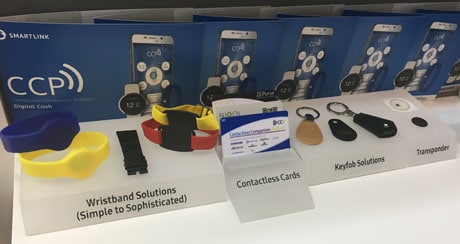
A digital cash service allowing consumers — including those without bank accounts — to load money onto a range of wearable items and make contactless payments in retail outlets will roll out across “eight or nine countries” in North America, Europe and Africa from April 2017.
Samsung, POS manufacturer Ingenico and Swiss app developer Smartlink will lead the roll out of the Contactless Companion Platform (CCP), developed by a partnership which also includes funds holder Cornercard and token service provider Carta Worldwide. Samsung expects “exponential growth” of the service once the pilot launch is completed in September 2017.
Among the wearable devices demonstrated with the launch of the service at Mobile World Congress in Barcelona last week was a watch from Swiss manufacturer WinWatch.
Director at Samsung Semiconductor Europe Thomas Arenz told NFC World a further range of fitness tracker and watch manufacturers were “in discussions” with Samsung to extend the service.
Rich and poor
“CCP bring contactless digital cash to everyone rich or poor,” Samsung says. “With CCP in place, you can make contactless payments via any enabled device of your choice, whether it’s a dedicated smart card, wristband, key fob, or even your watch or a smart ring.
“It offers full control of payment by validity, location, time or day, and other parameters you decide on during the remote top-up of a secure token with the sleek companion app on your smartphone.
“It has the ability to seamlessly combine payments with loyalty points, vouchers, travel cards, ticketing and more.”
Among the benefits of CCP cited by Samsung are:
- It is a tokenized service, making it as secure as existing mobile payments services such as Samsung Pay;
- It allows governments to improve social welfare programmes by giving those poorer in society the ability to top up at local welfare centres, but with set shopping parameters “to encourage the right kind of spending”;
- It gives parents the ability to safely transfer money to their children and ensure they can only spend it on what the parents deem appropriate, such as their lunch;
- A web-based or smartphone app interface, available for iOS and Android, to manage the service and deactivate the chip inside the wearable item if it is lost.
“This benefits the young, the unbanked, the elderly, and those on welfare, while offering greater transparency and greater knowledge of customers for retailers,” Arenz says.
Next: Visit the NFCW Expo to find new suppliers and solutions
Smartlink + Samsung = awesome